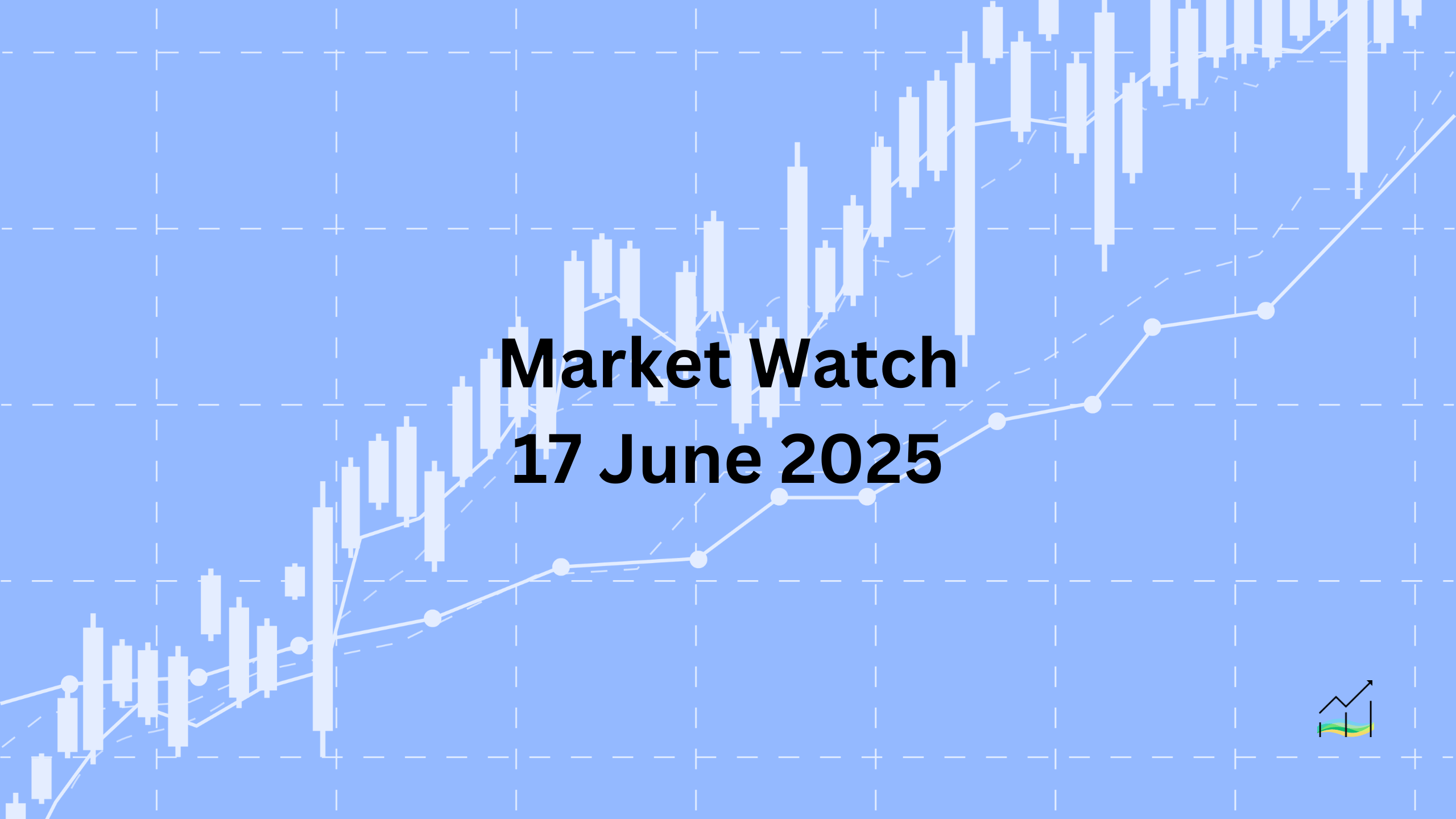17/06/2025 Market Watch

Markets Digest Geopolitical Risks as Risk Appetite Stays Fragile
Key Takeaways:
- Israel-Iran tensions persist, but market response remains muted.
- Oil prices remain high, but disruptions are mostly due to insurance concerns, not a formal blockade.
- US-UK trade deal signed on G7 sidelines, though key details are still pending.
- Dollar steady to stronger, particularly against emerging market currencies.
- Equities are mixed globally, with gains in Japan and Taiwan but broader weakness in Europe and the US.
- BOJ policy unchanged, tapering to begin next April.
- Bond yields diverge slightly across regions.
- Gold experiences sharp pullback, oil trades within a volatile range.
Tensions between Israel and Iran remain unresolved, but markets appear to be largely unshaken for now. Oil prices are still elevated, but there is no direct evidence of a blockade. Instead, private insurers are limiting traffic through the Straits of Hormuz, which is contributing to slower flows. At the G7 summit, President Trump dismissed a draft statement urging restraint in the Middle East, then cut the trip short to return to Washington. Despite no progress on trade with Japan, the US and UK signed a new trade deal, although important details, such as exemptions from steel tariffs, were not disclosed.
Currency markets are subdued, with the US dollar holding steady against G10 peers and mostly rising against emerging markets. Equity performance was mixed in the Asia Pacific region, where Japan and Taiwan posted gains while other regional markets fell. In Europe, the Stoxx 600 ended last week with consecutive losses before a mild rebound yesterday. Early European trading today shows further declines, and US futures are down, retracing a large part of Monday’s gains.
Japan's bond yields moved up slightly after the Bank of Japan left rates unchanged and announced a more gradual tapering plan beginning in April next year. European yields are mildly higher, while US Treasury yields have edged lower. Meanwhile, gold extended its steepest drop in a month, briefly falling below last week’s low. Oil remains volatile, with WTI bouncing between key levels but settling near the $71 mark.
United States of America
Overview
The US Dollar Index has remained within a tight range over the last three sessions, fluctuating between 97.60 and 98.50. Today’s positioning, currently between 98.05 and 98.30, continues to reflect market indecision ahead of a key policy announcement. A more substantial shift would require a move above 98.70, with the next critical resistance near 99.05. This level aligns with both a 50 percent retracement from the late-May high and the 20-day moving average, which the index has not breached all month.
This week, the spotlight is firmly on the upcoming Federal Open Market Committee (FOMC) decision. Although the week is shortened due to a holiday, a heavy calendar of real-sector data will still influence sentiment. Markets are particularly attentive to signs of softness in the US economy, especially in light of weakening job market indicators. Meanwhile, May retail sales and industrial production figures are being watched closely for signs of underlying strength or weakness in the real economy.
The broader narrative is shifting slightly toward a more dovish outlook. Market pricing via Fed funds futures suggests that traders are beginning to question whether two rate hikes are still realistic for the year. This is a notable divergence from the Fed’s previous projections, which have held consistent since December. The deterioration in jobless claims and subdued inflation pressures support a softer stance in the near term.
Economic Drivers
- Retail sales for May are expected to be weak due to poor auto sales.
- Core retail sales could show improvement after April's decline.
- Industrial production is likely to be unchanged for the second month in a row.
- Import and export prices show signs of softening, reinforcing disinflation trends.
- Labour market is showing cracks: jobless claims at highest levels in several months.
- Market expectations have turned more dovish compared to the Fed's March and December dot plots.
Data and Events
- 17 June 2025: Retail Sales.
Price Action
- Dollar Index remains within a narrow three-session range of 97.60 to 98.50.
- Key resistance lies near 98.70, with stronger resistance around 99.05.
- DXY has remained below the 20-day moving average throughout the month.
Key Points:
- Dollar remains rangebound, with no major breakout.
- Market attention is focused on upcoming FOMC policy direction.
- Retail and industrial figures point to subdued economic activity.
- Labour data supports the case for a dovish Fed shift.
- Technical resistance for the dollar is noted at 98.70 and 99.05.
China
Overview
The Chinese yuan has remained steady within a narrow trading band against the US dollar, with the range tightening even further in recent sessions. After four consecutive days of setting the dollar reference rate lower, the People's Bank of China (PBOC) made a modest upward adjustment before lowering it again to its weakest level in three months. This signals that the PBOC is guiding the yuan stronger, contrary to market speculation that a depreciation might be imminent.
Despite increased geopolitical tensions in the Middle East, China’s public stance has been measured. As the largest buyer of Iranian crude oil, accounting for up to 90 percent of Iran’s exports and roughly one-eighth of China’s own imports as of March, Beijing has economic interests tied to regional stability. Initially critical of Israel’s actions, China’s tone has shifted towards mediation, with diplomatic outreach to both Iran and Israel and calls for de-escalation. These efforts may reflect a broader strategy to position China as a neutral facilitator in global conflicts, particularly those that could impact energy flows or involve its strategic partners.
China’s alignment with both Iran and Russia remains significant in the context of ongoing strategic developments. It signed a long-term cooperation agreement with Iran in 2021 and has engaged in multiple joint naval exercises with both nations. These ties, combined with China’s energy dependencies, underpin its cautious yet calculated geopolitical positioning in the current crisis.
Economic Drivers
- PBOC has been guiding the yuan higher by adjusting the dollar reference rate downward.
- Contrary to external expectations, Chinese authorities appear to favour yuan stability or appreciation.
- China is Iran's largest oil buyer, importing nearly 90 percent of Iran’s output.
- Iranian crude accounted for about one-eighth of China’s oil imports in March.
- Beijing initially condemned Israel's actions but now calls for restraint and dialogue.
- China maintains strategic economic and military ties with Iran and Russia.
- Long-term cooperation agreements support Beijing’s broader geopolitical positioning.
Data and Events
No major economic releases are scheduled today.
Price Action
- Dollar trading within a tight CNH7.17 to CNH7.20 range since last Thursday.
- Current day’s range even narrower at approximately CNH7.1785 to CNH7.1875.
- PBOC reference rate lowered to CNY7.1746, the lowest in three months.
Key Points:
- Yuan remains stable despite external expectations of depreciation.
- PBOC is steering the currency stronger through daily fixings.
- China’s geopolitical response is balanced, with calls for diplomacy.
- Strong energy ties with Iran and ongoing alignment with Russia remain key.
- No major domestic data releases scheduled for today.
Europe
Overview
The euro is consolidating following a modest pullback from last week's high. After peaking near $1.1630 last Thursday, it retreated to around $1.1490 before stabilising. Yesterday’s session high reached $1.1615 in North American trade, but today marks the first session in four days where the euro has not surpassed $1.1600. The current tone suggests consolidation, especially in the absence of new catalysts. Traders are likely awaiting the upcoming FOMC decision, which is expected to drive broader market sentiment.
Meanwhile, Germany’s ZEW survey for June showed a notable improvement in economic expectations, extending the recovery seen in May. After dropping into negative territory in April due to concerns over US tariff threats, expectations have rebounded strongly. Although sentiment on the current economic situation remains weak, the June reading represents the most optimistic view since mid-2023. These figures reflect a more hopeful outlook for the second half of the year, though actual conditions on the ground continue to lag.
The improvement in expectations signals growing confidence among investors and analysts, potentially driven by receding fears over US trade policy and anticipation of stabilisation in the broader European economy. However, until there is a clearer shift in actual economic performance, the underlying weakness continues to temper optimism.
Economic Drivers
- Euro is stabilising after recent highs, with markets awaiting the FOMC outcome.
- Geopolitical risks, including Israeli-Iranian conflict or new US tariff moves, remain possible disruptors.
- German ZEW expectations index rose from 25.2 in May to 47.5 in June, showing improving sentiment.
- ZEW current conditions index improved from -82.0 in May to -72.0 in June, the highest since July 2023.
- Longstanding weakness in the assessment of current conditions still weighs on the broader outlook.
Data and Events
- 17 June 2025: German ZEW Economic Sentiment.
Price Action
- Euro peaked at $1.1630 last Thursday, then pulled back to $1.1490 pre-weekend.
- Recent trading is consolidating around $1.1555 in a narrow 15-tick range.
- Yesterday’s high at $1.1615 failed to break above recent resistance.
- First session in four days without trading above $1.1600.
Key Points:
- Euro is consolidating ahead of the FOMC meeting.
- ZEW expectations show strong recovery, while current conditions remain negative.
- Geopolitical and trade policy risks remain key watchpoints.
- No breakout in euro price action as markets await fresh catalysts.
Japan
Overview
The Japanese yen weakened as the US dollar climbed from a session low near JPY143.65 to a four-day high around JPY145.10. Last week's high was just below JPY145.45. The move followed the Bank of Japan’s decision to leave its benchmark interest rate unchanged at 0.50 percent, a widely expected outcome.
Governor Ueda reiterated concerns over unanchored inflation expectations and signalled caution regarding the real economy. Specific attention was drawn to the auto industry, a critical sector that employs approximately 5.6 million people and contributes around 10 percent of GDP. The governor also flagged risks stemming from US tariffs, which have yet to fully materialise in the data.
While the central bank’s current policy remains unchanged, it confirmed a reduced pace of tapering in government bond purchases beginning in the next fiscal year. From April 2026, the BOJ will cut bond purchases by JPY200 billion per quarter instead of the current JPY400 billion. This shift aligns with market expectations and reflects a more cautious approach to normalising policy. In response, long-term bond yields edged higher by 1 to 2 basis points.
Economic Drivers
- BOJ left the policy rate unchanged at 0.50 percent, in line with expectations.
- Governor Ueda remains concerned about inflation expectations and economic fragility.
- Auto sector risks flagged, employing 5.6 million and contributing 10 percent to GDP.
- Potential fallout from US tariffs still pending in real-sector data.
- BOJ tapering to slow from April 2026, halving the reduction in government bond purchases.
- Swaps market reflects declining expectations of a rate hike this year.
Data and Events
- 17 June 2025: BOJ Policy Rate.
- 17 June 2025: Monetary Policy Statement.
- 17 June 2025: BOJ Press Conference.
Price Action
- Dollar rose from JPY143.65 to JPY145.10, a four-day high.
- Last week's peak just under JPY145.45 remains a key level.
- Long-term JGB yields rose 1 to 2 basis points following BOJ tapering guidance.
Key Points:
- BOJ held rates steady and signalled caution on inflation and growth.
- Tapering of bond purchases to slow in April 2026.
- Dollar strengthened against yen, approaching last week’s highs.
- Bond yields reacted mildly to BOJ’s updated tapering plan.
© 2025 SKONE Enterprise (003319453-V). All rights reserved.
The content on this site is for informational purposes only and does not constitute financial advice.


